
About UsThe Numismatic Bibliomania Society is a non-profit organization promoting numismatic literature. For more information please see our web site at coinbooks.org SubscriptionsThose wishing to become new E-Sylum subscribers (or wishing to Unsubscribe) can go to the following web page link MembershipThere is a membership application available on the web site Membership Application To join, print the application and return it with your check to the address printed on the application. Membership is only $20 to addresses in the U.S., $25 for First Class mail, and $30 elsewhere. For those without web access, write to: David M. Sundman, Treasurer AsylumFor Asylum mailing address changes and other membership questions, contact David at this email address: dsundman@LittletonCoin.com SubmissionsTo submit items for publication in The E-Sylum, just Reply to this message, or write to the Editor at this address: whomren@gmail.com
BUY THE BOOK BEFORE THE COIN |
- WAYNE'S WORDS: THE E-SYLUM MAY 4, 2014
- BRUCE PERDUE WINS ANA PRESIDENTIAL AWARD
- LAKE BOOKS MAIL BID SALE #118 CLOSES MAY 6, 2014
- KOLBE & FANNING OFFERS RECENT WORKS
- GREEK NUMISMATIC LITERATURE SALE JUNE 2014
- NEW BOOK: MODERN WORLD PAPER MONEY, 20TH ED
- BOOK REVIEW: GRADING GUIDE FOR EARLY AMERICAN COPPER
- BOOK REVIEW: COINS OF LITHUANIA 1386 - 2009
- ENLARGING POLYMERS AND COUNTERFEIT DETECTION
- ON SHIPPING COINS TO SIBERIA
- MORE CAVE PAINTING ART IN NUMISMATICS
- NOTES FROM E-SYLUM READERS: MAY 4, 2014
- QUERY: NUMISMATIC PERIODICAL INDEXES SOUGHT
- QUERY: STUDY OF ENGRAVING STYLES SOUGHT
- HOW LONG DOES IT TAKE TO CUT A DIE?
- THE GEORGE WASHINGTON NATIONAL LIBRARY
- HARVEY STACK ON NUMISMATIC PEDIGREES
- THE GRANBERG CONTINENTAL DOLLAR IN SILVER
- THE BOYD-NEWMAN 1792 SILVER CENTER CENT
- COLORADO 'IN GOD WE TRUST' MONUMENT
- POLYMER BANK NOTE SUPPLIER INNOVIA GROUP BOUGHT
- DE LA RUE DESIGNS BANKNOTES TO DEFEAT COUNTERFEITERS
- ANTI-COUNTERFEITING COLOR-CODED MICROPARTICLES
- AUSTRALIA'S FIRST BANKNOTE MAY COME TO AUCTION
- ARTICLE HIGHLIGHTS BOB EVANS' RETURN TO THE SS CENTRAL AMERICA
- FUND BETS AGAINST CENTRAL AMERICA EXPEDITION
- NOAH WEBSTER’S AMERICAN ENGLISH
- HOBO NICKELS: I VILL AND JASON'S UNCLE
- CUOMO-MUST-GO OVERSTAMPS CIRCULATING IN NEW YORK
- RARE ALBERT MEDAL SOLD AT AUCTION
- BRITISH ARMY DOG AWARDED DICKIN MEDAL
- SIR JOHN HOUBLON £50 BANKNOTES BEING RETIRED
- COINS STRUCK FOR 2014 GLASGOW GAMES
- SCOTLAND CONSIDERS CURRENCY CHOICES
- RUSSIA, KAZAKHSTAN AND BELARUS PLAN JOINT CURRENCY
- THE MOORE PENNY BANK REFERENCE COLLECTION
- HORSE FEED PURCHASED WITH COUNTERFEIT BILLS
- FEATURED WEB PAGE: THE VICTORIA CROSS
Click here to access the complete archive
To comment or submit articles, reply to whomren@gmail.com
WAYNE'S WORDS: THE E-SYLUM MAY 4, 2014

Our new subscribers this week include S. McPike of the U.S. Mint, Matthew Wittmann, and Jura Iwlew. We have 1,724 email subscribers.
Last week's issue with the lead article on John Adams winning the Huntington Award was a big hit. Ray Williams forwarded it to all the colonial coin collectors in Yahoo groups, and Ben Weiss added a link to it on the Medal Collectors of America web site.
Favorite reader comment of the week: "Although your wife might disagree with me, I think you do everything right." - Fred Michaelson.
Happy Star Wars Day - May the Fourth be with you. This week we open with an award for one of the E-Sylum crew, numismatic literature sale notes from Fred Lake, David Fanning and Ursula Kampmann, and two book reviews.
Other topics include cave paining art in numismatics, periodical indexes, engraving styles, Newman colonial sale highlights, the Cuomo-Must-Go overstamp and the 'In God We Trus' monument.
To learn more about enlarging polymers, the first bi-metallic U.S. coin, color-coded microparticles, Hobo nickels, crazed psychos, the Victoria, Albert and Dickin medals, read on. Have a great week, everyone!
Wayne Homren
Editor, The E-Sylum
BRUCE PERDUE WINS ANA PRESIDENTIAL AWARD
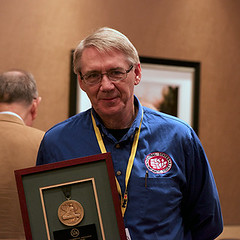 In Part 3 of his Central States Numismatic Society Convention Show Report Charles Morgan writes:
In Part 3 of his Central States Numismatic Society Convention Show Report Charles Morgan writes:
[American Numismatic Association] President Dr. Walter A. Ostromecki, Jr., was present at the CSNS Public Meeting to award incoming CSNS President Bruce Perdue with the ANA Presidential Award. Those in attendance congratulated Bruce on receiving what is the third highest award the ANA bestows upon its members.
To read the complete article, see: Central States Numismatic Society Convention Show Report: Part 3 (www.coinweek.com/featured-news/central-states-numismatic-society-convention-show-report-part-3/)
LAKE BOOKS MAIL BID SALE #118 CLOSES MAY 6, 2014
This is to remind you that our mail bid sale #118 of numismatic literature closes on Tuesday, May 6, 2014 at 5:00 PM (EDT). You may view the 477-lot catalog at www.lakebooks.com/current.html and bids may be placed via email, fax or telephone until the closing time.
The selections from the libraries of Jay H. Cline and Harry Warren feature many Special Edition Redbooks including ones presented to contributors and special leather bound issues, a long run of the John J. Ford catalogs, a number of Bowers & Merena hard-bound sales, books on Paper Money, Tokens and Medals and some bulk lots of scarce older catalogs.
Good Luck with your bidding, Fred
Lake Books
PMB 118
6822 22nd Ave. N
St. Petersburg, FL 33710-3918
727-343-8055 FAX: 727-381-6822
KOLBE & FANNING OFFERS RECENT WORKS
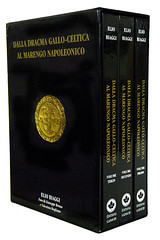 Kolbe & Fanning Numismatic Booksellers have been increasing the number of new publications we carry on our website for immediate purchase. A few examples of recent numismatic books available from K&F include:
Kolbe & Fanning Numismatic Booksellers have been increasing the number of new publications we carry on our website for immediate purchase. A few examples of recent numismatic books available from K&F include:
Parsley, Donald L. UNITED STATES EARLY HALF DOLLAR DIE VARIETIES, 1794-1836. The new fifth edition. $85.00
Biaggi, Elio. DALLA DRACMA GALLO CELTICA AL MARENGO NAPOLEONICO. Three volume set, housed in matching slipcase. $500.00
Nilsson, Harald. ERIK WALLERS SAMLING AV MEDICINHISTORISKA MEDALJER. Beautifully illustrated in color. $110.00
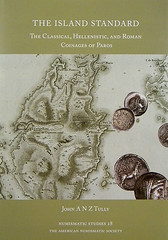 Tully, John A.N.Z. THE ISLAND STANDARD: THE CLASSICAL, HELLENISTIC, AND ROMAN COINAGES OF PAROS. Numismatic Studies No. 28 by the ANS. $100.00
Tully, John A.N.Z. THE ISLAND STANDARD: THE CLASSICAL, HELLENISTIC, AND ROMAN COINAGES OF PAROS. Numismatic Studies No. 28 by the ANS. $100.00
Siboni, Roger S., John L. Howes and A. Buell Ish. NEW JERSEY STATE COPPERS: HISTORY, DESCRIPTION, COLLECTING. The long-awaited work. $215.00
Sylloge Nummorum Graecorum. GREECE 7. THE KIKPE COLLECTION OF BRONZE COIS. VOLUME I. With 126 full-page plates depicting 1233 coins. $119.00
Sylloge Nummorum Graecorum. TURKEY 5. TIRE MUSEUM VOLUME 1: ROMAN PROVINCIAL COINS FROM IONIA, LYDIA, PHRYGIA AND, ETC. With 40 plates of coins with facing descriptions. $100.00
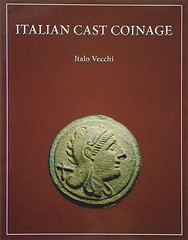 Vecchi, Italo. ITALIAN CAST COINAGE. The new standard reference. $90.00
Vecchi, Italo. ITALIAN CAST COINAGE. The new standard reference. $90.00
Taillard, Michel, and Michel Arnaud. ESSAIS MONÉTAIRES & PIÉFORTS FRANÇAIS 1870-2001. A new work from Éditions Gadoury. $70.00
If your only experience with Kolbe & Fanning is with our auctions and mail-bid sales, please take a few minutes to check out our website at www.numislit.com. Well over 1,000 new and used books are available at fixed prices and can be searched or browsed by category. We look forward to hearing from you.
GREEK NUMISMATIC LITERATURE SALE JUNE 2014
If there is anything in the world that puts the BCD collection of ancient Greek coins in the shade, it is the BCD library, which is by far the largest privately owned library on Greek numismatics that ever existed. The collector, who has been documenting every written remark about Greek numismatics in it for several decades and who gladly makes this treasure of knowledge accessible to interested academics, has now entrusted the young company Auctiones GmbH with auctioning some intriguing duplicates in their eAuction 28. As of 16 June 2014, all 227 lots can be viewed online, at www.auctiones.ch, and it is also possible to place pre-bids. The actual electronic auction will start on 29 June at 7 p.m. sharp.
As is to be expected of a bibliomaniac like BCD, among the duplicates the expert discovers any number of very interesting rarities, items highly useful and important, with publication dates as early as the 19th century until today. Not surprisingly, the focus is on the ancient period (Greeks, Celts, Romans, Byzantines) but nevertheless, there are some interesting publications available that deal with medieval and modern coins and medals.
The range covers a larger number of languages because BCD collected virtually everything published related to the topic. Hence, it contains many English publications but likewise German, Italian, French, Russian and Greek ones, not to forget such language exotics like Rumanian and Hungarian. The offer comprises die studies, monographs, collections of essays, coffee-table books, offprints, and auction sale catalogs, that all have one thing in common: there is something special connected with them.
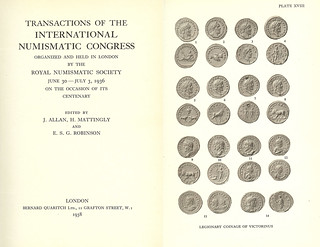 Let us take, for example, lot 7, the Transactions of the International Numismatic Congress held in London in 1936. The copy available here, offered for CHF 30 – although no book lover will seriously expect to get the book for as low a price – was once owned by the famous numismatist Willy Schwabacher who, in the year of the congress, had just been barred from the DAI excavations in the Kerameikos in Athens because of his Jewish extraction.
Let us take, for example, lot 7, the Transactions of the International Numismatic Congress held in London in 1936. The copy available here, offered for CHF 30 – although no book lover will seriously expect to get the book for as low a price – was once owned by the famous numismatist Willy Schwabacher who, in the year of the congress, had just been barred from the DAI excavations in the Kerameikos in Athens because of his Jewish extraction.
When the transactions of the congress were published in London in 1938, Schwabacher also happened to be at London where he had been able to flee to. He continued his career first in Copenhagen, then after another flight in Stockholm as friend of Gustav VI Adolph, King of Sweden, who not only had a great interest in archaeology but also collected coins. Thus, these transactions tell us their own story in addition to the academic articles it contains.
And that is something. BCD who – and everybody who owns the catalogs of his coin collection can vouch for the truth of that – never abstains from voicing his sincere opinion, describes the contents as follows: “Apart from Sir George Macdonald’s Presidential Address on what was then the last Fifty years of Greek Numismatics”, [contains this book] the kind of articles that can only produce a feeling of despair when one compares “then” with “now”; there are many more interesting and useful scholarly contributions on practically every branch of numismatics, including medals.”
Another impressive bibliophilic rarity is an edition of the sought-after monograph written by Friedrich Imhoof-Blumer on the coins of Acarnania from 1878, which the former owner made unique by its binding: there is an original stater from Acarnania depicting the bull-headed Acheloos on its obverse embedded into the leather-bound cover.
Or just think of the immense oeuvre of unforgotten Leo Mildenberg who is represented by a couple of very special testimonies of which the lion’s share has been widely unknown so far: cases in point are a magnificently written article on Greek fractions from 1964 or the catalog of an exhibition of the Zurich Museum of Arts and Crafts from 1949 behind which Leo Mildenberg was the driving force.
So much more could be said about all the books offered for sale in this auction. Anyone not just fond of coins but likewise of books will find something to his liking in eAuction 28 of Auctiones GmbH, something that is going to enrich his library and that will make his eyes sparkle with joy. Make sure of paying www.auctiones.ch a visit after 16 June 2014. Further information is available at Auctiones GmbH, P.O. Box 673, 3000 Bern 8, Switzerland; phone: +41313113948, email: info@auctiones.ch
7. [London Congress] J. Allan, H. Mattingly and E. S. G. Robinson (eds.), Transactions of the International Numismatic Congress organized and held in London by the Royal Numismatic Society, June 30 - July 3, 1936 on the Occasion of Its Centenary. London 1938. 8vo (17x23cm), green linen with gilt spine letters; 490 pages, 27 plates. Spine ends worn. Very Good. Estimate: 30 CHF.
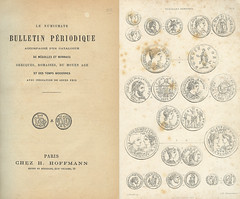
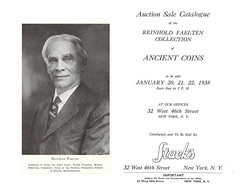
8. Le Numismate. Bulletin Périodique. Accompagné d’un catalogue de médailles et monnaies grecques, romaines, du moyen age et des temps modernes avec indication de leurs prix. Années 1862-64. Paris. 8vo, quarter black leather, gilt spine letters; 220 pages + 3203 catalogue numbers + 2558 catalogue numbers, etc., 7 plates of engravings. Good. Estimate: 100 CHF.
23. Stack’s. New York, 20 - 22 January 1938. Reinhold Faelten Collection of Ancient Coins. 2169 lots, portrait frontispiece, 94 pages, 27 tissue-guarded plates. Prices realized list. 4to, quarter tan leather with embossed brown spine letters. Some margin discoloration to last plates, not affecting photos. Near Fine. Estimate: 45 CHF.
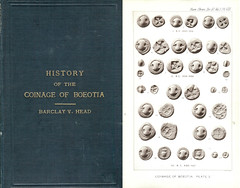
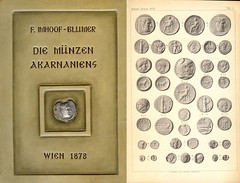
96. Barclay V. Head, History of the Coinage of Boeotia. London 1881. 8vo, dark green cloth, gilt letters; 99 pages, 6 plates. Originally published as “On the Chronological Sequence of the Coinage of Boeotia” in NC ser. III, vol. 1. Binding slightly split at spine, hinges cracked. Good. Estimate: 35 CHF.
101. F. Imhoof-Blumer, Die Münzen Akarnaniens. Wien 1878. Original offprint of the article appearing in NZ X (1878). 8vo, full tan leather, dark brown letters, with a genuine AR stater depicting the head of Achelous embedded in the front cover. 186 pages, 3 plates. Newly bound, still in binder’s wrap. Fine. Estimate: 100 CHF.
THE BOOK BAZARRE
NEW BOOK: MODERN WORLD PAPER MONEY, 20TH ED
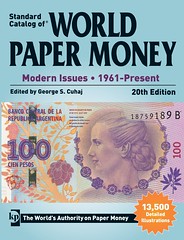 A new edition of the Standard Catalog of World Paper Money - Modern Issues is now available from Krause Publications.
A new edition of the Standard Catalog of World Paper Money - Modern Issues is now available from Krause Publications.
A network of more than 80 international paper money collectors and dealers work with editor George S. Cuhaj to ensure that the Standard Catalog of World Paper Money - Modern Issues, is the most comprehensive resource available for proper identification, description and valuation of modern world bank notes. All circulating paper bank notes worldwide are included in this one-of-a-kind catalog.
- Completely analyzed and updated pricing.
- Extensively illustrated with hundreds of new or improved images.
- Numerous previously unlisted varieties, including specimens, are now featured.
- Expanded descriptions allow less experienced users, speculators or estate appraisers to correctly identify notes.
- Proper identification, description and valuation of modern world bank notes. All circulating paper bank notes worldwide are included in this one-of-a-kind catalog.
For more information, or to order, see:
2015 Standard Catalog of World Paper Money - Modern Issues, 20th Edition
(www.shopnumismaster.com/2015-standard-catalog-of
-world-paper-money-20th-edition-grouped)
BOOK REVIEW: GRADING GUIDE FOR EARLY AMERICAN COPPER
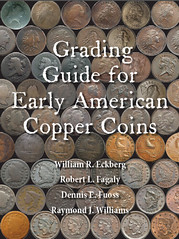 Grading Guide for Early American Copper Coins
Grading Guide for Early American Copper Coins
by Bill Eckberg, Bob Fagaly, Dennis Fuoss, Ray Williams
Early American Coppers, Inc.
2014
192 pages
ISBN 978-0-615-91186-1
Appropriately in time for this week's convention of the Early American Coppers Inc. (EAC), their new grading guide has popped to the top of my review stack. Since I'm no expert in the topic I'll keep my remarks from the bibliophile's perspective.
The long-awaited book fully describes the process of grading early American copper coins as practiced by collectors who specialize in them. "EAC Grading" is distinct from, and typically more precise and stringent than grading by third-party grading services and auction houses.
The book became available to EAC members at their convention in Colorado Springs, CO, May 1-4, 2014 and will be available to the public beginning tomorrow.
The cover price is $54.95 plus $5 P&H. EAC or C4 members in good standing get a $5 discount. Members purchasing the book at the EAC convention will pay only $45. All proceeds from the book will go to EAC to support its educational and outreach activities.
The rationale for EAC grading is laid out in the Introduction:
Because copper coins were the money of the people and (unlike gold coins) were heavily used in commerce, because they are heavy and soft, and because copper is more reactive to oxidation than silver or gold, they received more wear and damage than early gold and silver coins. Because their relative value did not fluctuate like that of gold and silver coins, they were less subject to mass meltings during their time of circulation. Thus, many stayed in circulation until they were unrecognizable due to wear or corrosion.
The different grading standards early copper specialists use from the commercial standards in the rest of US numismatics, and the different way they account for damage to coins from that used by the rest of numismatics adds an extra level of complexity and concern for those who might wish to collect these endlessly fascinating coins. This book addresses that complexity and concern by thoroughly describing the grading standards and processes used by specialists in the field and comparing them to the commercial standards and processes used in the rest of numismatics, with the goal of making copper collecting easier, more enjoyable and more fulfilling for all.
Grades from About Good to Mint State (and higher Mint State grades, where such coins exist) of nearly all series are illustrated by full color photos twice the diameter of the coin.
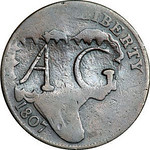 The Guide is not without humor, as exemplified by this illustration from p16 captioned, "While there are many ways to record a coin’s
grade, this is definitely not the way to do it."
The Guide is not without humor, as exemplified by this illustration from p16 captioned, "While there are many ways to record a coin’s
grade, this is definitely not the way to do it."
The Introduction also provides a useful history of coin grading in the U.S., including the Sheldon numerical “Grades” from 1 to 70, Photograde, and the third-party grading services.
Chapter 2 outlines the EAC Grading Guidelines, summarized as follows:
An EAC grade usually consists of two grades. The first refers to the sharpness or degree of wear on the coin, i.e., the technical grade. The second is a net grade after accounting for any post-strike impairment(s) to the coin, i.e., the market grade. If there is a single grade, that means the coin has no significant impairments, and the net grade is the same as the sharpness grade. Commercial grading does not give separate sharpness and net grades, but provides a single overall grade.
The full-color images are extremely helpful; a great example is the color set on pages 18-19.

Chapter 3 delves into Authentication, and the meat of the book is found in chapters 4-6 on the grading of Confederation Era Coppers, Half Cents and Large Cents. Confederation Era Coppers include New Jersey, Connecticut and Vermont coppers, Massachusetts Cents and Half Cents, and Fugio Cents.
The Grading Guide easily passes my back-of-the-book test. Appendices beginning on p145 (of the 192-page book) constitute a full 25% of its content. Appendix I "provides some details pertaining to die clash, die breaks, and die state in the context of grading, for specific large cent varieties." These short notes, arranged by date and Sheldon variety, seem very useful, pointing out specific features and other diagnostic clues to varieties.
Appendix II is a concise 3-page compilation of Photo Credits for the book's wonderful images, many of which are used courtesy of Ira and Larry Goldberg, Heritage Auctions, Stacks-Bowers Galleries, or individual collectors including Mike Packard, Neil Rothschild and Alan Weinberg.
The ten-page Glossary is useful for far more than just grading, covering relevant numismatic terms from A-Z including Annealing, Cherrypick, Dentils, Die Clash, Medal alignment, Oxidation, Patina, Re-engraving Undertype, and Verdigris.
And such early copper-specific terms such as Booby Head, Nichols Find, Silly Head, and Whist Match.
Here's one example definition:
Happening: a party or meeting at which specialists share particular coins and information about them; from the first Half Cent Happening, which took place in 1976 in Ann Arbor, MI. Such events are now held at every EAC Convention and are dedicated to colonials, half cents, large cents and bust silver coins
And here's a term I don't think I'd heard before:
Keg Mark: nick on the surface of a coin that could have resulted from contact with other coins in a keg that was used to store the coins before they went into circulation.
QUICK QUIZ: without consulting the book, who can provide a definition for the term "Gynandroid" ?
In summary, it's an easy call to highly recommend this book to any collector or dealer in early U.S. copper coins, as well as to general students of U.S. numismatics. There's a lot here for everyone to learn. Bill Eckberg informs me that over half of the print run has already been sold, so don't miss out - if you have any interest at all, order your copy soon.
For more information, or to order, see: www.eacs.org
BOOK REVIEW: COINS OF LITHUANIA 1386 - 2009
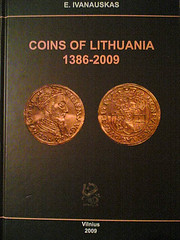 Coins of Lithuania 1386-2009. A Catalogue
Coins of Lithuania 1386-2009. A Catalogue
ISBN: 97899557721613
Paperback: 408 pages
Author: Eugenijus Ivanauskas
Year: 2009
Language: English
Price: LTL350.00
This is a very comprehensive on Lithuanian coins. 407 pages with pictures at 1:1 scale. Provides mint, diameter, weight and rarity as well as value for some coins. The book was written in English and only 500 copies were printed 100 of which are on a very high quality paper. I was fortunate to trade for one of the 100.
The book is laid out in chronological order by ruler and smallest denomination to largest. There are also pages containing much of the history of the coins. Which includes reasons certain things were done and even who ran the mint at the time and the die sinker.
To order, see: Coins of Lithuania 1386-2009. A Catalogue (www.ehobbex.com/node/7284)
To read the complete discussion, see: (www.worldofcoins.eu/forum/index.php?topic=27212.msg175786#msg175786)
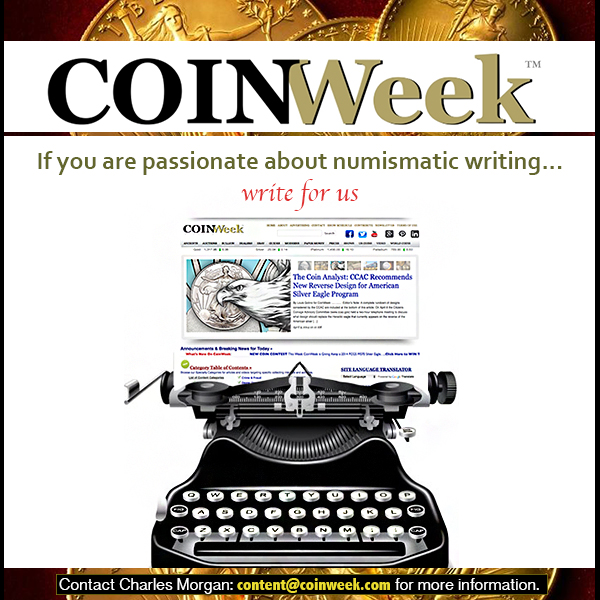
ENLARGING POLYMERS AND COUNTERFEIT DETECTION
The post about the "enlarging polymer" offers a solution to a counterfeit detection problem I've been working on.
I have a 1887 Victoria Crown which appears to be a good quality lost wax casting. It even has the sprue phonied up as a "rim ding". The only problem is the coin is full weight (within the remedy of the 1870 British Coinage Act), and the diameter of the coin looks OK (within a few 100s of a mm of what would be expected). However, if it's a lost wax casting, it should be 2-3% underweight and the diameter should be similarly undersized.
By using the enlarging resin, and soaking it only long enough to increase the mould 3%, the problem of differential shrinkage is solved.
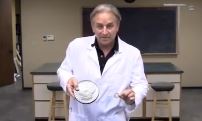 I don't see how mentioning the name of the product could somehow "let the cat of the bag" in this day of instant access to everything. The company's website shows coins being made.
I don't see how mentioning the name of the product could somehow "let the cat of the bag" in this day of instant access to everything. The company's website shows coins being made.
The sooner that authenticators know about this material, the better. Up to now most would assume that lost wax castings have to be underweight and undersized. That old crutch no longer holds, folks.
Bob's note solves one additional mystery for me - the material expands in water at a known rate, so to expand something by a given amount, you remove it from the water at a precise time. This still allows for some variability, but at a decreased level of inaccuracy. -Editor
To read the earlier E-Sylum article, see: HONEY, I SHRUNK THE MEDALS! (www.coinbooks.org/esylum_v17n18a12.html)
ON SHIPPING COINS TO SIBERIA
Chris Fuccione writes:
I saw the piece about the thirteen year old collector in Siberia looking for coins for his club. One place I would suggest that they check out is the American Numismatic Association Young Numismatist program, because they know how to encourage and support collectors that age and they might have some ideas of Russian coin clubs that they can join and support.
I also found on the internet a website for The Russian Numismatic Society (RNS). It is a US-based club for collectors of Russian coins. From how their website looks I'm not sure how active the club is but there is contact information. The officers of the club might be able to steer them in the right direction.
www.money.org/explore-the-world-of-money/young-numismatists.aspx
www.russiannumismaticsociety.org
Justin Perrault writes:
Unfortunately there are any number of restrictions on what can be mailed through USPS, one of which is foreign currency. See the following link for international restrictions: http://pe.usps.gov/TEXT/IMM/ps_013.htm#ep1603920 .
Now I'm not saying a delivery would not get there, it just runs the risk of seizure. This regulation is probably in place to keep large amounts of cash from being transferred illicitly, not the occasional numismatic specimen, but that is all up to the postal inspector to decide. Otherwise, there is always UPS or FedEx, if they deliver to such remote locations, but I could only imagine at what cost that would come.
To read the earlier E-Sylum article, see: NOTES FROM E-SYLUM READERS: APRIL 27, 2014 : Siberian Club Seeks Coin Donations (www.coinbooks.org/esylum_v17n18a08.html)
MORE CAVE PAINTING ART IN NUMISMATICS
Greg Adams writes:
You asked about medals with Cave Painting art… How about these from the Medallic Arts, National Park Series?

Mammoth Cave, KY medal

Gila Cliff Dwellings, NM medal
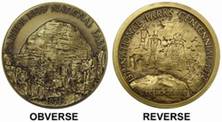
Capitol Reef, UT National Park medal
Greg adds:
There are also a couple of NCLT coins from Niue and Palau that come up when you search on eBay.
To purchase national Parks Medals at the Northwest Territorial Mint, see: Store : National Park Medallions (medallic.com/store/national_park.html)
Yossi Dotan writes:
You ask about cave painting art medals. I know of one such coin, also a Finnish one. The image of the coin is attached, downloaded from the web site of the Bank of Finland. I described the coin as follows in my book Watercraft on World Coins, Vol. I: Europe, 1800-2005.
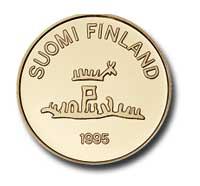
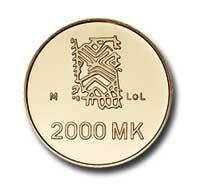
50th Anniversary of the End of World War II
KM-79 2000 markkaa 1995 .900 gold
The obverse features two elk boats. The somewhat mysterious comb-like motif is based on prehistoric Scandinavian and Karelian rock carvings dated to the later Stone Age. Some archaeologists believe that the carvings depict prehistoric boats with an elk head as a figurehead (probably made of wood); however, no remains of such boats have been found and the interpretation is conjectural. The reverse features a fishing net based on a prehistoric Finnish rock painting. The symbolism of the obverse and reverse designs is difficult to interpret and there is nothing on the coin to indicate that it was struck to mark the end of World War II. In Finland this war with Germany, the so-called Lapland War, ended on 25 April 1945.
To read the complete web page, see:
Commemorative coins
(www.suomenpankki.fi/en/setelit_ja_kolikot/markat/
pages/juhlarahojen_lunastaminen.aspx)
To read the earlier E-Sylum article, see: MORE ON THE FINLAND 10 EURO LITERACY COIN (www.coinbooks.org/esylum_v17n18a16.html)
NOTES FROM E-SYLUM READERS: MAY 4, 2014
Ed Moy on the Mint Directors' Conference Former Director of the U.S. Mint Edmund Moy writes:
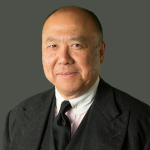 If you are blessed to become a director of a government mint, you automatically become a member of the Mint Directors' Conference (MDC). The MDC has a formal conference once every two years hosted by a member (during my years, it was in South Korea hosted by KOMSCO and in Australia hosted by the Royal Australian Mint). It's a chance for the directors and staff to gather and share best practices and learn about trends. The MDC also meets informally once a year during the World Money Fair held in Berlin, Germany in February, where discussions usually revolve around governance and membership.
If you are blessed to become a director of a government mint, you automatically become a member of the Mint Directors' Conference (MDC). The MDC has a formal conference once every two years hosted by a member (during my years, it was in South Korea hosted by KOMSCO and in Australia hosted by the Royal Australian Mint). It's a chance for the directors and staff to gather and share best practices and learn about trends. The MDC also meets informally once a year during the World Money Fair held in Berlin, Germany in February, where discussions usually revolve around governance and membership.
As the director of the largest mint in the world, the United States is expected to provide leadership to the MDC and its opinion carries a lot of weight with the members. While I took that responsibility seriously, I took the view that fostering thoughtful discussion and consensus decisions was the leadership legacy I wanted to leave. As a result, I developed deep relationships with mints that had a similar philosophy like the Royal Mint, Monnaie de Paris, the Italian Mint, Royal Australian Mint, and the Japan Mint.
I was privileged to be part of this august group of public servants and miss seeing the many friends that I made regularly.
To read the earlier E-Sylum article, see: FEATURED WEB SITE: MINT DIRECTORS’ CONFERENCE 2014 (www.coinbooks.org/esylum_v17n18a26.html)
More on Lincoln Cent Dates Dave Lange writes:
The article about lettering and numeral styles of the Lincoln Cent reprinted from Slate reminded me of a column I wrote some years ago for The Numismatist that is now available on the NGC website. There were several installments, but this is the one on Lincoln Cents.
To read the complete article, see: DANCING WITH DATES, PART ONE (www.ngccoin.com/news/viewarticle.aspx?NewsletterNewsArticleID=525)
To read the earlier E-Sylum article, see: LINCOLN CENT TYPOGRAPHY DESIGN HISTORY (www.coinbooks.org/esylum_v17n18a11.html)
More on Hussey's Private Message Post Rich Hartzog writes:
In the book Philatellic Forgers: Their Lives and Works, issued by Linns, there is an article on George A. Hussey. Some of the info:
Hussey was an American who operated a local independent post in New York City from 1854 until about 1873. Realizing the interest that prevailed among collectors of postmasters' stamps, carriers' issues, and local stamps in the 1860s, he purchased, whenever possible, the dies and plates of these issues in order to prepare reprints from them. If these could not be obtained, he forged the stamps.
There are four long paragraphs on Hussey. Note the date differences in this article vs. Werner Mayer's dates. [1840s - Editor]
To read the earlier E-Sylum article, see: NOTES FROM E-SYLUM READERS: APRIL 27, 2014 : Hussey's Private Message Post (www.coinbooks.org/esylum_v17n18a08.html)
Rochester Public Market Wooden Nickel Token
Regarding the "wooden nickel" style SNAP (Supplemental Nutrition Assistance Program) token discussed earlier, Nick Graver writes:
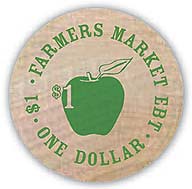
The Rochester Public Market web site illustrates one token.
To read the earlier E-Sylum article, see: ROCHESTER PUBLIC MARKET ADOPTS WOODEN TOKENS (www.coinbooks.org/esylum_v17n17a18.html)
An Odd Elk Counterstamp Dick Hanscom writes:
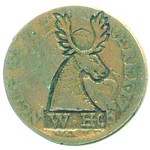 I have had this odd elk counterstamp for over 30 years. It is on a French 1790-M 1 Sol.
The lettering appears to be W (raised period) H-C (H joined to C). It appears that the tops and bottoms of the legs of the H are joined. Perhaps there is more here than meets the eye.
Any thoughts from E-Sylum readers would be appreciated.
I have had this odd elk counterstamp for over 30 years. It is on a French 1790-M 1 Sol.
The lettering appears to be W (raised period) H-C (H joined to C). It appears that the tops and bottoms of the legs of the H are joined. Perhaps there is more here than meets the eye.
Any thoughts from E-Sylum readers would be appreciated.
Training Learning Banknotes Dave Ginsburg forwarded this eBay auction lot:
100 Dollars 100Pcs The United States Bank of America Training Learning Banknotes UNC
Replica Not legal tender!!!
This is ornamental learning favorite commemorate appreciate supplies,Not legal tender, This is not in circulation. Please read the description as good before buying.
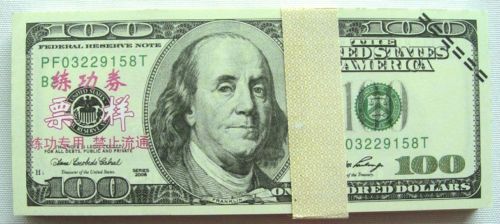
To read the complete eBay listing, see: 100 Dollars 100Pcs The United States Bank of America Training Learning Banknotes (www.ebay.com/itm/100-Dollars-100Pcs-The-United-States-Bank-of-America-Training-Learning-Banknotes-/111337670388)

Archives International Auctions, Part XIX
U.S. & Worldwide Banknotes, Scripophily, Security Printing Ephemera, "The Tasmanian Devil Collection" of rare Australian & New Zealand Banknotes and Further Selections from the Hamtramck Collection.
Highlights include:
- Lot 33 Commonwealth of Australia, Reserve Bank, ND (1974) Issue $50 Specimen Banknote
- Lot 494 Bank of America, 1879 Specimen $10,000 Clearing House Certificate
- Lot 589 Accelerating Steam Navigation Co., 1852 Issued Stock Certificate - Obsolete Look-A-Like

1580 Lemoine Avenue, Suite #7
Fort Lee, NJ 07024
Phone: 201-944-4800
Email: info@archivesinternational.com
WWW.ARCHIVESINTERNATIONAL.COM
QUERY: NUMISMATIC PERIODICAL INDEXES SOUGHT
Bruce W. Smith writes:
In my library I have a Xerox copy of an index to Coin Collectors Journal, second series, published 1930's to 1950's, by Charles M. Johnson. Do any of our E-Sylum readers know when and where this was published? It appears to cover Volumes 1 through 20, but I didn't copy the title page or cover. I don't remember now where I found this in the first place.
And while we are on the subject, does anyone know of a listing of indexes to numismatic periodicals?
Also, does anyone know where I can find a set of Numismatic Bulletin, published by the Pacific Coast Numismatic Society? Is it still being published? I would like to buy or borrow the issues before 1970. Thanks.
Indexes are very valuable to researchers. The late Harry Bass recognized this and created NIP, the Numismatic Index of Periodicals. Included are both the first series Coin Collector's Journal, 1875-1888, by Scott Stamp and Coin Co. and the second series, 1934-1954, published by Wayte Raymond.
Unfortunately, when Harry died the project languished and hasn't been kept up to date. But the American Numismatic Association took it over from the Bass Foundation and hosts the static database on its web site. -Editor
To search NIP, see: Harry W. Bass, Jr. Index (nip.money.org/NumismaticIndexes_list.asp)
QUERY: STUDY OF ENGRAVING STYLES SOUGHT
During the period of 1968 to 1971, I worked as a cartographer. That is a person who draws maps. For some maps the lettering was added with strips of tape that contained lettering. Some lettering was done with dry transfer lettering. Some were lettered by hand in ink.
The ink lettering was done with a template and a stylus that followed the form of letters in the template. Various typefaces were available in various sizes.
I have ordered awards that have engraved plates. I pick the style I want from printed samples of the available type faces. I believe that the engraving is then done by a tool that follows the letters in a template, much like the lettering that we did on maps. The text on a plate that I order in Minneapolis might appear identical to another produced by a similar machine anywhere in the country.
At the recent Central States show, I talked with Mike Bean, former plate engraver with the Bureau of Engraving and Printing. He showed me an example of very small printing done from an engraved steel plate. I suspect that steel plate engravers used some type of similar guides.
I am not familiar with the history of such engraving. There may have been a time when letter engraving was done by hand with no guide. I suspect there was a period of time and transition between early guides to whatever system is used today. When did these changes occur?
I wonder if anyone has attempted a study of the engraving on coins, medals or love tokens. If it hasn't been done, perhaps somebody could write a book with examples of engraving that will identify the period when engraving was done and the method that was used.
Is there a way to tell if engraving was done free-hand or done with the assistance of a template? Can a style of lettering be used to date the item that is engraved? Can the style of lettering identify where or how the engraver was trained? Perhaps some reader of The E-Sylum can provide this information.
To read the earlier E-Sylum articles, see:
ON COMPARING HAND-ENGRAVING STYLES
(www.coinbooks.org/esylum_v17n18a07.html)
LINCOLN CENT TYPOGRAPHY DESIGN HISTORY
(www.coinbooks.org/esylum_v17n18a11.html)
HOW LONG DOES IT TAKE TO CUT A DIE?
This is in answer to Paul Bosco who asked the question in last week's E-Sylum of how long does it take to cut a die. He responded to Peter Betran's comments in the previous week on Alan Weinbergs's original article. I guess you could call this a "thread" in internet parlance.
How long depends on many things: type of die, skill of the engraver, size of the die, complexity of the die and how fast the customer wants the die completed (or items struck from a die).
A hand engraver might engrave a die in a day's time, or longer considering conditions mentioned.
A diesinker could "cut a die," that is, using only letter punches could finish a die of all lettering in an hour or two. This might surprise token collectors that many of the tokens in your collection were knocked out -- two sides and struck -- in a morning's time, provided it was struck in a soft composition, like aluminum Cheap stuff.
A die with a relief device might require several days to engrave the device, then another day to sink that device, and another day to add letter punches, say four or five days total.
A hand controlled machine cut die (also called a tracer controlled die) -- as with a Gorton -- requires either a drawn design or a pattern cut in plastic. Then the machine operator hand controls the placing of the cutting tool by following the outline of the frawing, or the edges in plastic. He also determines the depth of cutting by hand controls. He must be skillful as any slip of the cutting tool could ruin a die and he would have to start all over. He literally forms all detail and all lettering. Even so a skilled machine operator could do one or two dies a day.
A modelled die, that is one made from a sculptor's model, not counting his time -- formerly took three days to make a metal pattern, say, for a 3-inch medal, and three more days on the Janvier pantograph. Now an epoxy pattern can be modeled in an hour or so, but is allowed to cure before placing it on a reducing machine or cutting a die by computer, saving another two days.
Formerly, when working with sculptors, we told clients we needed a minimum of six-week turnaround time. That gave a sculptor ample time to design and model. Say two weeks to create a design in their mind, even while working on something else, and a week to model each side. Now it takes somewhat less using an epoxy instead of a metal pattern.
In the 19th century when most dies were hand engraved it may have been less than a day's time. But remember it was a 12-hour work day then, six days a week.
I just finished a study of the Lovett family of engravers with the cooperation of Dave Baldwin and Katie Jaeger, both Lovett experts. The 2-year period just prior to the Civil War, say 1860-61 were their most active.
Robert Lovett Junior in Philadelphia cut 87 pair of dies, Robert Senior cut 7 pair, while in New York, George Hampton cut 184 pair and John D, cut 16.
Although there was a lot of muleing and use of a favorite device punch over and over I estimate the four engravers created about one die a day, a pair in two days.
To read the earlier E-Sylum article, see: ON COMPARING HAND-ENGRAVING STYLES (www.coinbooks.org/esylum_v17n18a07.html)
THE GEORGE WASHINGTON NATIONAL LIBRARY
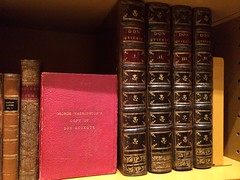 I was in D.C. this week at a library conference, where I gave a paper Friday on the topic of “Coinage, Politics, and Power: Preservation grants at the library of the American Numismatic Society.”
I was in D.C. this week at a library conference, where I gave a paper Friday on the topic of “Coinage, Politics, and Power: Preservation grants at the library of the American Numismatic Society.”
I had the opportunity to spend the day Thursday at George Washington's Mount Vernon and got a tour of the library from the head librarian and archivist, Mark Santangelo. (Mark was previously the long-time librarian of the Greek and Roman Art department of the Metropolitan Museum of Art, which is where we became friends, as I also worked there for 3 years).
Mark has been at Mount Vernon since 2012 and oversaw the construction and opening of the new library there, which is absolutely beautiful. I’m attaching some photos from my visit: there is a reading room with a lot of natural light, a nice rare book room (which includes two cases of Washington medals!) with collections that include letters of George and Martha Washington, books from Washington’s original library, among many other treasures.
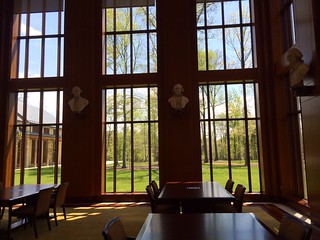

The last photo is Mark standing in front of a portion of Washington’s original library and a sculptural enlarged version of Washington’s bookplate (which appears in volumes from his collections). One of the treasures of the collections is George Washington’s copy of Acts Passed at Congress… (1789) , which sold at a Christie’s auction in June 2012 for almost $10 million! Visitors can purchase a beautiful facsimile copy of this work at the bookstore.
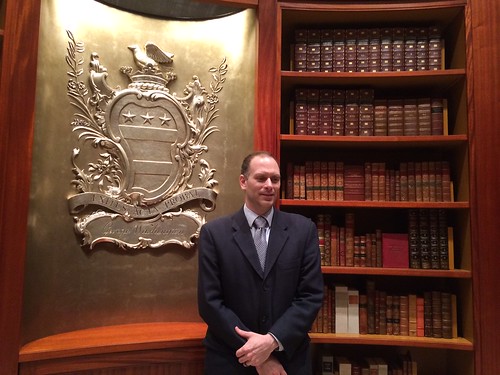
Items in the library are searchable in their online library catalog, and anyone familiar with the ANS library catalog will find a lot of similarities (they use the same library system called Koha):
librarycatalog.mountvernon.org/cgi-bin/koha/opac-search.pl?
q=coin&x=-559&y=-728
There is a lot of information on their website so I’ll include some links here and encourage readers to reach out to Mark if interested!
www.mountvernon.org/library
www.mountvernon.org/library/staff
As a final note, it makes a fun day trip from D.C. as it is only about a 30 minute drive from the city in a very scenic area of Virginia and you can also tour Mount Vernon itself, which is steps away from the library.
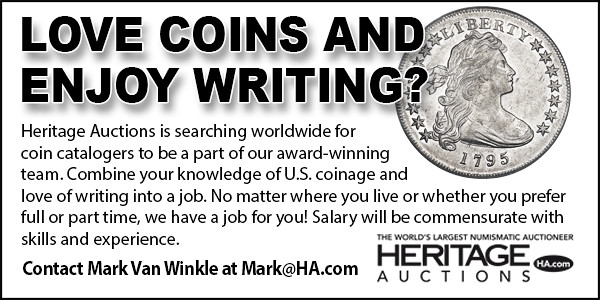
HARVEY STACK ON NUMISMATIC PEDIGREES
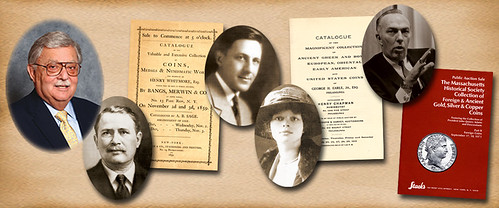
Last time I mentioned the collection of the Adams family of Massachusetts. By the early l830s the members of the family had accumulated thousands upon thousands of documents, showing history and events from our early colonial days, through the War of Independence and the early days of the Industrial Revolution in the 1830s.
A depository was established in the recently endowed Massachusetts Historical Society. Many documents, books, coins and currency were placed there for those who wished to study and learn more about the development of the United States of America. The massive collection of coins was given to the Society by John Quincy Adams, along with letters, documents and notes saved from earlier days.
The coin collection was carefully housed in large wooden library type cabinets, fitted with drawers to accommodate the extensive collection. The collection included American coins and currency, from pre-colonial days up to about the time of John Quincy Adams, as well as foreign pieces. The collection itself revealed a lot about the economic development of America and reflected the world coins that were available to the members of the Adams family.
For many decades the collection resided in the care of the Society and was available for collectors to examine and scholars to study. However, there was no special curator and the care of the coins was not always well attended to. In order to limit the coins’ exposure to various elements, it was decided to store the collection in the Boston Museum of Fine Arts, (currently known as The Museum of Fine Arts or MFA).
In the mid 1960s it was discovered that funds were needed to preserve and restore many of the rare history related documents from the Adams Family and other sources. The cost for the project was immense, so the curators of the MFA, under the leadership of Cornelius Vermuele (a senior curator of Antiquities and Numismatic items), recommended that since the coins are rarely if ever seen, they be sold to provide the funds to preserve the important papers of early America.
In the late 1960s, after Stack’s was chosen to sell the Adams Family Collection coins, my cousin Norman Stack and I went to Boston and were taken down to the area where the coins were stored. We worked with the curators to select a representative collection that could be retained for display purposes, if so desired, in the halls of the Society.
We then made an inventory, packed the coins carefully, and sent them in a large group of special trunks to New York for cataloging and eventual auction. The entire Stack family was thrilled to handle this great American numismatic treasure, realizing the historical importance of its link to the Adams family. It was like being a part of history knowing that for over 150 years these coins had remained first in one family and then housed under their direction in one of the oldest museums in America.
The collection was so vast that we used several catalogs to sell them at Public Auction. Each of the lots were put into 2X2 envelopes, stating it was from the Massachusetts Historical Society Collection sold at public auction, then the date of the sale and the lot number. On the rear flap of the envelope it said Stack’s New York.
By putting the name of the society, the date of the sale, the lot number, and the auctioneer on the envelope, we established the pedigree of each coin being sold. If the new owner retained it with the coin, this envelope provided a way for the pedigree to continue into the future. Those who attended our first sale in 1970 and the sales that followed speak of the historical importance of the offering and how the retention of the pedigree added to both pride of ownership and the coin’s value.
Since then, many catalogs (ours as well as others) offering coins from this historical collection, have noted the envelope to enhance value of the coin.
As a final note, the documents that were preserved and saved by the Massachusetts Historical Society became a source for an extensive book about the Adams family. In turn, this book led to a series on Public Television that told the story of the Adams family as revealed by the documents saved and kept by the Society.
Working with and cataloging the coins from the Adams Family Collection and learning about the historical items the Adams family passed on, was among the most exciting and satisfying happenings of my numismatic career.
To read the complete articles, see:
The Value of a Pedigree, Part 3
(www.stacksbowers.com/NewsMedia/Blogs/TabId/780/ArtMID/
2678/ArticleID/64464/The-Value-of-a-Pedigree-Part-3.aspx)
The Value of a Pedigree, Part 4
(www.stacksbowers.com/NewsMedia/Blogs/TabId/780/ArtMID/
2678/ArticleID/64476/The-Value-of-a-Pedigree-Part-4.aspx)
The Value of a Pedigree, Part 5
(www.stacksbowers.com/NewsMedia/Blogs/TabId/780/ArtMID/
2678/ArticleID/64484/The-Value-of-a-Pedigree-Part-5.aspx)
To read the earlier E-Sylum article, see: HARVEY STACK ON NUMISMATIC PEDIGREES (www.coinbooks.org/esylum_v17n16a14.html)
THE GRANBERG CONTINENTAL DOLLAR IN SILVER
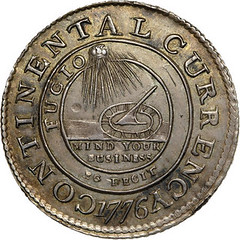

Eric P. Newman published The 1776 Continental Currency Coinage in 1952, and the work remains the standard reference for the series today. The Continental Currency dollars were struck primarily in pewter, but a few examples are known in brass and silver. Newman identified five obverse and four reverse dies, which were combined to produce seven different die varieties for the series.
Eric P. Newman, Don Taxay, Walter Breen, Philip Mossman, and Michael Hodder spent many years researching the Continental Currency coinage, mesmerized by its mysterious origins. No authorization for the production of the Continental Currency coinage has come to light, but it is probable that the coins were intended to take the place of the dollar-denominated paper currency issued by the Continental Congress in the latter part of 1776.
The four resolutions from May 10, 1775 to May 9, 1776 provided for the issue of paper money in various denominations, including the one dollar bill. The six resolutions of July 22, 1776 through September 26, 1778 omitted the one dollar denomination. Thus, it is logical to conclude the pewter pieces were intended as a substitute for the paper dollars in those issues. The coins had minimal intrinsic value, and like the paper bills they replaced, were valued according to the public's confidence in Congress, who guaranteed their value at one dollar each.
The present coin is the discovery example of the Newman 3-D in silver, which first came to the attention of U.S. collectors through a query in the January 1887 edition of the American Journal of Numismatics. On page 72, the following question was posted by prominent Philadelphia coin dealers S.H. & H. Chapman:
"In an English Sale Catalogue (Dec. 17) we note the following: 'Chain Dollar, silver. Obv. Sundial, Continental Currency, 1776, rev. Chain, American Congress, rare and very fine.' Have any of our collectors this coin in SILVER?"
Numismatic literature authority Charles Davis informs us that the "English Sale Catalogue" referred to must be the Sotheby's offering of the Williams, Smith, Clark and Solly Collections, held on December 17, 18, 20, and 21, 1886. The April 1887 issue of the AJN included the following letter from the Chapman brothers, who seem to have acquired the coin in the meantime.
The editors of the AJN disputed the Chapmans' assertion that the sundial side was the obverse of the coin, siding with Crosby in thinking the identity of the government issuing the coin should be specified on the obverse. However, in his 1859 American Numismatical Manual, Montroville W. Dickeson designated the sundial as an obverse device. The Chapmans reasoned that the Continental Currency notes displayed the sundial on the obverse, and the coin design should follow suit. Modern authorities, including Eric P. Newman, have adopted the position of Dr. Dickeson and the Chapmans.
The Chapman brothers consigned their "latest important acquisition" to the Frank McCoye sale of May 5, 1887, their next auction. The coin was described in lot 238 of the catalog, with a page and a half of text that vigorously defended their attribution of the sundial side as the obverse. The coin was plated in the catalog, along with a Continental Currency note for comparison, to further strengthen their claim. Unfortunately, the coin did not receive a high enough bid to satisfy the Chapman brothers, who had a significant investment in it by that time, and the lot was withdrawn. Philadelphia collector George Earle purchased the coin privately sometime after the sale.
The second decade of the 20th century saw a surprising amount of numismatic activity involving the Continental Currency dollar in silver. A second example of the Newman 3-D in silver surfaced in the collection of H.O. Granberg of Oshkosh, Wisconsin. Granberg exhibited his coin at the Chicago ANA Convention in 1911, and it was the subject of an article by Edgar Adams in the New York Sun, reprinted in the April 1912 issue of The Numismatist. Henry Chapman offered the present coin in lot 2132 of the sale of George Earle Collection in June of 1912. The coin passed to Baltimore financier Waldo Newcomer, for a strong price of $2,200. Both examples of the Newman 3-D in silver were exhibited in the 1914 ANS Exhibition, the Granberg coin described on page 19 of the catalog and the present coin on page 21, with an image of this piece on Plate 13. After this period of rather intense activity, no mention was made regarding the silver Continental Currency dollars for quite some time. By the early 1930s, the two coins found their way into the fabulous collection of "Col." E.H. R. Green.
The former Granberg coin emerged from "Col." Green's estate sometime before 1947, when it was offered by Stack's in lot 10 of the Theodore Grand Collection. Prominent collector F.C.C. Boyd acquired the coin there and it later passed to John Jay Ford, Jr. When Ford's collection was sold through Stack's a decade ago, this uncertified Extremely Fine graded specimen realized $425,500. The present coin was acquired from the Green Estate by Burdette G. Johnson. Upon his death, ownership passed to Mary Cruzan, and Eric P. Newman acquired it in 1956. It is being offered at auction for the first time in more than a century.
The 1776 Continental Currency dollars are among the most important and historically interesting issues in all of American numismatics. They have a distinctively American character, as our first dollar coin, although not denominated as such. They were struck at a crucial time in our nation's history. The young country badly needed a medium of exchange to continue to finance the American Revolution, and to promote confidence in the paper currency as well. The silver pieces are among the rarest and most valuable coins in the American Colonial series.
To read the complete lot description, see: 1776 $1 Continental Dollar, CURRENCY, Silver, EG FECIT MS63 NGC. Newman 3-D (coins.ha.com/c/item.zx?saleNo=1199&lotNo=30423&ctrack=2765472)
THE BOYD-NEWMAN 1792 SILVER CENTER CENT
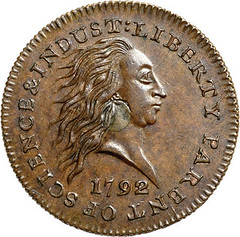
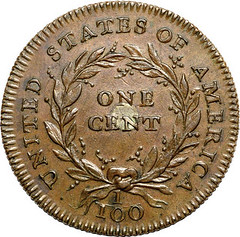
The 1792 patterns represent the founding fathers' first attempt to establish a national coinage that was efficient to use (unlike the earlier Nova Constellatio patterns). The Mint Act of April 2, 1792 authorized the establishment of a national mint to issue coinage for the fledgling United States and set down some specific guidelines for that coinage. Section 9 of the Mint Act stipulated that cents were to contain 11 pennyweights (264 grains) of pure copper.
Unfortunately, a copper coin of that weight would be too large and unwieldy for practical purposes. The ingenious chief coiner, Henry Voigt, suggested including a plug of silver in a more appropriately sized copper planchet to create a coin with an equivalent intrinsic value and a more convenient size than the originally envisioned large copper piece. The silver plug was to be conical in shape and inserted into a tapered hole in the copper planchet with the wider top of the plug on the obverse of the coin. When the resulting bimetallic planchet was struck on the screw press, the protruding edges of the plug would be fused with the surrounding copper and actually receive part of the design. A note in Henry Voigt's journal indicates that the first Silver Center cents were struck on December 17, 1792 and Thomas Jefferson reported on the new patterns in a letter to President George Washington the following day:
"Th. Jefferson has the honor to send the President two cents made on Voigt's plan by putting a silver plug worth ¾ of a cent into a copper worth ¼ of a cent. Mr. Rittenhouse is about to make a few by mixing the same plug by fusion with the same quantity of copper. He will then make of copper alone of the same size, and lastly he will make the real cent as ordered by Congress, four times as big."
To read the complete lot description, see:
1792 P1C One Cent, Judd-1, Pollock-1, High R.6, MS63+ Brown
(coins.ha.com/c/item.zx?saleNo=1199&lotNo=30426&ctrack=2765472
&type=hero-right--coin--1199-newman-open--tem042914)
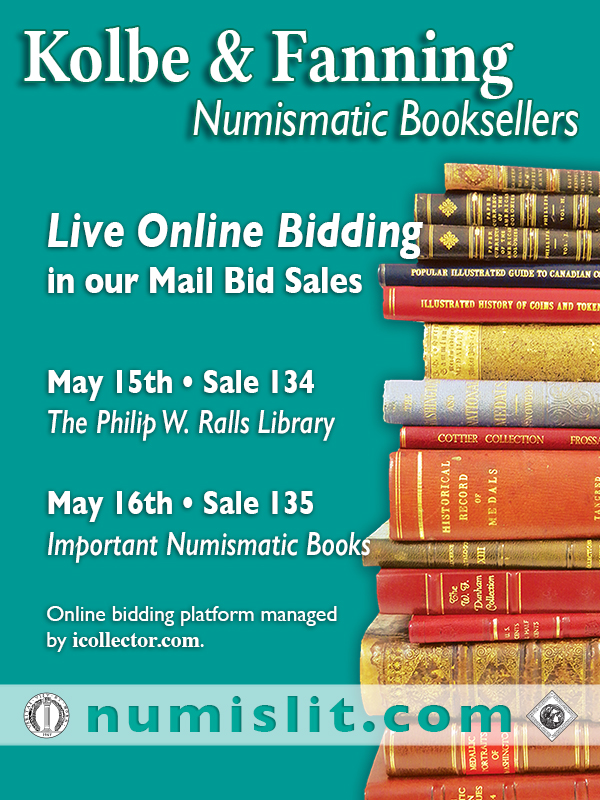
COLORADO 'IN GOD WE TRUST' MONUMENT

The "In God We Trust" monument at the Col. Leo S. Boston War Memorial Park recently was featured in "The Numismatist" magazine after author and photographer Robert B. Kelley happened to be driving by and viewed it.
The Numismatist features articles on such topics as coins, tokens, medals, paper money and stock certificates.
The monument spells out the "In God We Trust," which was made by students in the Cañon City High School metal shop, who made the letters out of 4-by-8-foot sheets of steel.
After the letters were built, volunteers dumped the pennies into a cement mixer, filled with vinegar and silica sand to clean them so they could be glued to the letters.
War Memorial Committee member and Vietnam veteran Dennis Withers said he expects the final "T" to be completed in the near future. The committee had to do some repair on the final "T" when the epoxy cracked. The "T" will be completed with the saying, "You've never lived until you've almost died. For those who fight for it, life has a flavor to protect, you will never know."
For each American life that was lost in Vietnam, there are 58,272 pennies attached to the monument, dated between 1965 and 1971.
"We collected (the pennies) at a different rate than what we posted them," Withers said. "Our biggest years for casualties in Vietnam were 1967, 1968 and 1969."
The original wall and the brick was established around 1996 or 1997, Withers said. The first phase to complete the Memorial Park started about 2004.
To read the complete article, see: 'In God We Trust' monument featured in "The Numismatist" magazine (www.canoncitydailyrecord.com/ci_25650013/god-we-trust-monument-featured-numismatist-magazine)
POLYMER BANK NOTE SUPPLIER INNOVIA GROUP BOUGHT
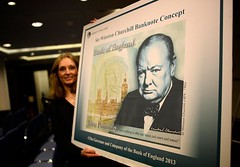 The private equity firm Arle Capital Partners said on Monday that it had agreed to acquire the Innovia Group, a company set to supply materials for Britain’s new plastic bank notes.
The private equity firm Arle Capital Partners said on Monday that it had agreed to acquire the Innovia Group, a company set to supply materials for Britain’s new plastic bank notes.
The deal gives Innovia, based in Wigton, England, an enterprise value of 498 million euros, or about $690 million.
Innovia, which employs about 1,600 people, is a maker of films used in labeling, packaging and polymer bank notes. It was awarded a contract this year to supply materials for the new plastic 5 pound and 10 pound notes.
The new notes are expected to be introduced beginning in 2016, with a new “fiver” featuring the visage of Winston Churchill.
To read the complete article, see: Arle Capital to Buy Supplier of Plastic Bank Notes (dealbook.nytimes.com/2014/04/28/arle-capital-to-buy-supplier-in-new-british-bank-notes/)
DE LA RUE DESIGNS BANKNOTES TO DEFEAT COUNTERFEITERS
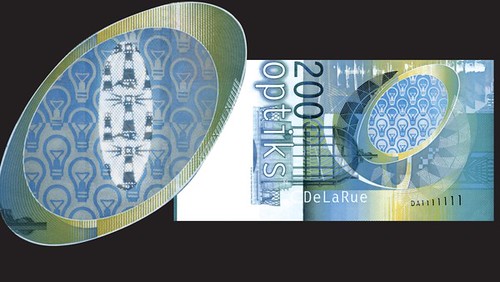
Malcolm Knight holds a banknote up to the window. As the light hits the paper, a shiny oval of blue lightbulbs on the face of the note suddenly disappears, revealing – as if by magic – a cluster of lighthouses. “It’s very hard for a counterfeiter to rise to that challenge,” he says.
Mr Knight is a former research and development director and now consultant at De La Rue, the discreet British banknote maker that has designed more than 40 per cent of the paper currency to have entered global circulation in the past two years.
Since 2008, it has worked on about 150 currencies either as printer, designer or provider of secure paper. It is trusted by central banks around the world for its security features that can shield a currency from forgers.
When South Sudan became the world’s youngest country in 2011, it was De La Rue that got the call to provide the banknotes. It also designed and produced the first notes in post-Gaddafi Libya and hired 24 jumbo jets to supply Iraq after the fall of Saddam Hussein.
The disappearing lightbulbs might seem like a cute trick. But the technology lies at the heart of the battle to uphold the value of the world’s paper currency against the evolving threat posed by “digifeiting” – forgery made possible by home technology.
It also forms the heart of De La Rue’s mission to keep the banknote – a product that accounts for almost two-thirds of its revenues – relevant in a world of ecommerce, mobile payments and virtual currencies.
To read the complete article, see: The bold designs that deter banknote forgers (www.ft.com/intl/cms/s/2/b5939538-ae91-11e3-8e41-00144feab7de.html)
ANTI-COUNTERFEITING COLOR-CODED MICROPARTICLES
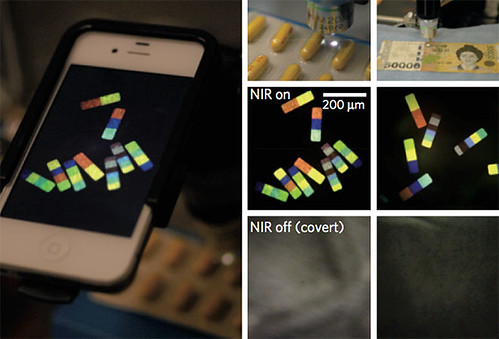
Counterfeiters beware: Scientists have developed a new microscopic barcode that can be embedded into currency, credit cards, and industrial packaging. The striped microparticles are invisible to the naked eye, and only reveal their color-coded bands when excited by near-infrared light. The tiny codes can be read under a microscope, or even with a modified smartphone, with error rates of less than one in 1 billion.
Paul Bisso, now a graduate student at MIT, initially teamed up with chemical engineer Patrick Doyle and colleagues to design better tags for identifying biomolecules in lab samples. But the group soon realized that the bar-coded microparticles could be adapted for other applications, including counterfeit prevention or quality control.
Commercially available micro-tagging kits, which can simultaneously measure multiple proteins or nucleic acids in biological fluids, typically offer thousands of unique codes, each represented by a different colored bead or particle, says Bisso. The lab’s latest design boosts this number by combining different colors in distinctive stripe patterns. For example, a single microparticle can encode up to a million different signals using six stripes in ten possible colors. Combining hundreds or thousands individually coded particles together pushes the information ceiling even higher.
“You could barcode every grain of sand on earth,” said Bisso.
The stripes get their colors from inorganic nanocrystals laced with rare-earth elements such as gadolinium, ytterbium, or erbium. These elements change the way the crystals respond to light, causing them to give off visible light of different colors when excited by invisible light in the near-infrared range. So far, the scientists have concocted about ten different hues by mixing different combinations of rare-earth elements.

Looking ahead, the researchers are confident that the technology can be readily scaled for commercial production. The microparticle-making machine is around the size of a laptop and should cost about the same, according to Bisso’s projections. And each particle takes about 100 milliseconds to produce. “Imagine a factory or very large room with 100 of these devices,” he said. “You’re talking about on the order of tens to hundreds of millions of particles per hour. That’s perfectly do-able on the industrial scale.”
Doyle is now working to streamline the LED attachment that enables smartphones to illuminate and read the micro-codes. “We really want to make it a compact, easily handheld device,” he said.
To read the complete article, see: Color-Coded Microparticles Could Thwart Counterfeiters (www.wired.com/2014/04/color-microparticle-barcodes/)

AUSTRALIA'S FIRST BANKNOTE MAY COME TO AUCTION

It's the first banknote struck by the nation of Australia, and an important landmark in the country's history, but a 10-shilling note dating from 1913 looks set to fall into foreign hands because no local buyer can be found.
The mint banknote, which last sold for $1.9 million in 2008, has been on the market for almost a year. It was originally valued at $3.5 million by Melbourne broker Coinworks, which is selling it on behalf of administrators McGrathNicol.
The sale period ends on Wednesday and, with no bids, spokesman Anthony Black said offers of $1 million ''would be seriously considered if it helped stop the banknote from being sold overseas''.
If the note is not sold, it will go to London auction house Spink and Son, which specialises in coins and banknotes. ''Once it's there, we are pretty confident the buyer will be from Britain and not Australia,'' Mr Black said.
Negotiations with the National Library of Australia, which had shown interest in the banknote, broke down in February. Billionaires Kerry Stokes, Gina Rinehart and Clive Palmer have also been approached.
After the Labor Party won control of both houses of parliament at the 1910 election, the Australian Notes Act was passed, which gave the Commonwealth the power to issue bank notes. The first 10-shilling note was issued at a ceremony at the government's print works on Flinders Lane in Melbourne on May 1, 1913, in the presence of prime minister Andrew Fisher and governor-general Lord Denman.
The Age the next day recorded that the governor-general's five-year-old daughter, Judith Denman, was given the honour of ''operating the numbering machine for the first note'' and produced 10-shilling note M000001. Lord Denman then produced note M000002 and his son, Thomas, note M000003.
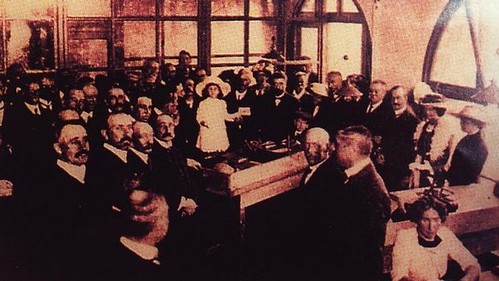
Judith Denman producing 10-shilling note M000001
To read the complete article, see: Australia's first banknote to head offshore (www.smh.com.au/national/australias-first-banknote-to-head-offshore-20140429-zr1e3.html)
ARTICLE HIGHLIGHTS BOB EVANS' RETURN TO THE SS CENTRAL AMERICA
 Once again, geologist Bob Evans is ready to hear the treasure of the SS Central America shipwreck tell its stories.
Once again, geologist Bob Evans is ready to hear the treasure of the SS Central America shipwreck tell its stories.
Twenty-six years after he and an unlikely crew of scientists, sailors and shipwreck enthusiasts found the ship’s remains at the bottom of the Atlantic Ocean, Evans is traveling with a new crew to once again uncover the vessel’s secrets.
“It’s happening all over again,” an emotional Evans said on Tuesday, a day before he set off on the Odyssey Explorer from the port of Charleston. “I always thought sooner or later it would come back to me.”
Odyssey Marine Exploration, which owns the Odyssey, has been hired by a court-appointed receiver to bring up the gold, silver and other artifacts that were left behind in 1991, the last time Evans and his fellow deep-sea explorers visited the wreck.
Evans was the right-hand man for Tommy Thompson, a Battelle scientist who had dreamed up the recovery effort in the early 1980s and convinced friends and Columbus-area investors that his quest could be successful.
Evans and Thompson had been friends since the late 1970s. Thompson relied heavily on Evans’ historical and scientific knowledge as he formulated plans to find the Central America and then, beginning in 1988, to recover its cargo.
The massive recovery vehicle they used, remotely operated and cutting-edge at the time, was able to go deep into the ocean where divers couldn’t and pick up the ship’s remains.
Once artifacts were brought to the surface, Evans catalogued each one and cleaned and preserved them. That included several tons of gold and silver, which eventually sold for more than $40 million.
Now, more than two decades later, Evans is the only original crew member returning to the shipwreck.
“I’m excited to apply the new technology on the site,” he said last week as he showed visitors the “coin room” on the Odyssey, where he’ll once again catalogue, store and keep track of the gold they expect to bring up.
While the basics of the robot are the same — lights, mechanical hands and cameras that beam photographs to the ship above — the sophistication level has been dramatically improved with digital photography, modern computers and crew members expert in maneuvering the robot and viewing the shipwreck.
Remembering the earlier expeditions to the shipwreck is like seeing yourself as a character in literature, said Evans. Since the find, he became an expert on the recovered gold coins and has given speeches across the country about the treasure and the expeditions.
Most of his time is spent on his small farm in Muskingum County, but he’ll remain on the Odyssey this summer.
To read the complete article, see: Ohio geologist returns to shipwreck treasure after two decades (www.dispatch.com/content/stories/local/2014/04/28/geologist-returns-for-new-look-at-treasure.html)
To read the earlier E-Sylum article, see: BOB EVANS SETS SAIL FOR THE S.S. CENTRAL AMERICA (www.coinbooks.org/esylum_v17n18a06.html)
FUND BETS AGAINST CENTRAL AMERICA EXPEDITION
 Odyssey Marine hopes to retrieve an estimated $86 million in gold from the SS Central America, a steamship sunk during a hurricane in 1857 while it carried large amounts of gold from California. The publicly traded, Tampa-based company is entitled to a substantial percentage of the riches. Naturally, Odyssey Marine is promoting the possibility of a big score on its website.
Odyssey Marine hopes to retrieve an estimated $86 million in gold from the SS Central America, a steamship sunk during a hurricane in 1857 while it carried large amounts of gold from California. The publicly traded, Tampa-based company is entitled to a substantial percentage of the riches. Naturally, Odyssey Marine is promoting the possibility of a big score on its website.
Not everybody is persuaded. Ryan Morris, an activist hedge fund manager who has shorted Odyssey Marine’s stock, insists that nothing of great value is left on the sunken vessel.
Odyssey Marine and Morris should both be familiar to readers of Bloomberg Businessweek. In 2012, staff writer Susan Berfield chronicled the volatile career of Greg Stemm, Odyssey Marine’s co-founder and chief executive officer. That year, Karen Weiss, a reporter at the magazine, profiled Morris, at 28 years old a rarity in the hedge fund world.
Hostilities between Stem and Morris began in November, when Morris released a 66-page report on Odyssey Marine, arguing that its stock “was worth zero.” At the time, Odyssey Marine dismissed Morris’s work as full of “factual errors, incomplete information, and erroneous conclusions.” When Odyssey Marine announced its plan to go poking around the SS Central America, Morris published a less voluminous, but still scathing study, arguing that the company was embarking on a fool’s errand.
Morris may have good reason to be skeptical. This is the second time that a team of underwater explorers has visited the SS Central America. In 1988, a fortune hunter named Tommy Thompson led a team that located the SS Central America and returned with a stash of gold that he eventually sold at auction for $52 million.
Some have advanced the theory that a huge cache of gold then under guard by the U.S. Army remains on board.
Morris finds this laughable. He says he and his team have interviewed Thompson’s first mate, reviewed court records, and looked at historical documents without finding anything to support the presence of these riches. He insists that without such a discovery, Odyssey is in trouble. “The only way it is a home run project is if they found this secret army gold,” Morris said in an e-mail. “Otherwise, they are literally picking coins out of the skeletons of 425 dead passengers."
Odyssey Marine brushes off the activist investor’s attacks. “Our research department and the court-appointed experts all believe there is enough gold remaining at the SS Central America to warrant the expense of conducting an expedition,” Odyssey Marine President Mark Gordon told Bloomberg News.
To read the complete article, see: The Hedge Fund Kid and the Treasure Ship (www.businessweek.com/articles/2014-04-29/the-hedge-fund-kid-and-the-treasure-ship)
THE BOOK BAZARRE
NOAH WEBSTER’S AMERICAN ENGLISH
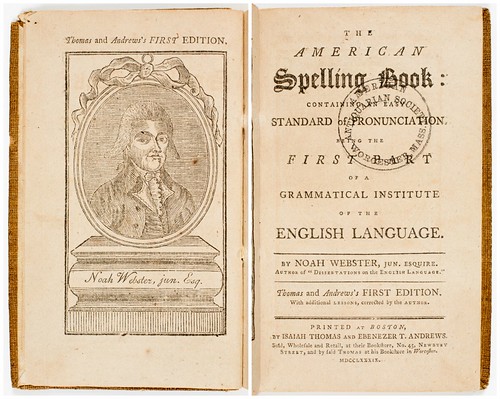
Noah Webster was born on October 16, 1758 to a well-respected West Hartford, Connecticut family. He and his siblings received a great deal of attention from his parents in the form of instruction on religion, morality, and academic subjects. In The Forgotten Founding Father (2010), Joshua Kendall argues that Webster gleaned from his upbringing an admiration for his authoritarian parents as well as a view of himself dependent on his accomplishments (15).
He engaged in private studies with a local pastor before entering Yale College in the 1770s, where he developed revolutionary sympathies as he lived through events like the Battles of Lexington and Concord, after which he showed his patriotism by joining his classmates in a student-directed military drill.
After graduating from college in 1778, Webster turned to the law profession. He soon redirected his career to teaching for a more stable income, and founded a successful school in Sharon, Connecticut in 1781. Webster went back and forth between teaching assignments for a number of years. He then turned his attention to what would be a best-selling project, uniting his ambitions for nationalism, “fame and silver dollars” (Kendall, 71).
In these post-Revolutionary years, Webster voiced strong convictions that a national language would unify the independent and distinct states. He published his American Spelling Book in 1783 as the first of a three-part series on the English language. Webster wrote in his preface that he wished to “diffuse uniformity and purity of language in America [and] destroy provincial prejudices” which he believed had arisen as a result of unstandardized spellings and varied pronunciations of words.
Webster borrowed heavily from Thomas Dilworth’s A New Guide to the English Tongue, printed in England in the mid-eighteenth century. Webster added key modifications, however, including the fact that the language of his speller was more readable (Kendall, 72). Furthermore, he employed standardized syllables that reflected pronunciation, as opposed to Dilworth’s syllables based on Latin grammatical rules (Kendall, 74).
Webster also included moral lessons instead of heavy Christian concepts. His Spelling Book took off, selling a million and a half copies between 1783 and 1801. This number is significant considering that the U.S. population was only about 2.8 million people in 1780 (Lemon, 122). AAS holds multiple editions of the Spelling Book, including a 1789 edition and a corresponding digital copy.
To read the complete article, see: Noah Webster’s American English (pastispresent.org/2014/good-sources/noah-websters-american-english/)
HOBO NICKELS: I VILL AND JASON'S UNCLE
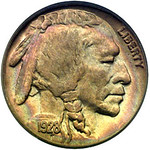 Hobo nickels are a distinctive American art form. The classic Indian Head nickel (or "Buffalo") turned out to make a great platform for carvers who worked on the soft metal to create new designs. (Coinfacts.com image at left).
Here are a couple Hobos found on eBay.
Hobo nickels are a distinctive American art form. The classic Indian Head nickel (or "Buffalo") turned out to make a great platform for carvers who worked on the soft metal to create new designs. (Coinfacts.com image at left).
Here are a couple Hobos found on eBay.
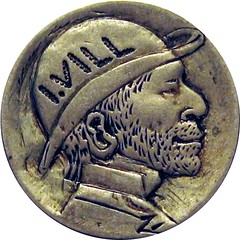 Larry Dziubek forwarded this one. The seller describes it as follows:
Larry Dziubek forwarded this one. The seller describes it as follows:
Original Hobo Nickel. I. Vill (marriage proposal acceptance or engraver's signature??) with hobo image on Buffalo nickel.
The "Z" at the bottom looks more like a signature to me. What do readers make of the "I. VILL" inscription?
To read the complete eBay lot description, see:
I Vill Original Hobo Nickel Marriage Proposal Acceptance Or Engraver Signature ?
(www.ebay.com/itm/I-Vill-Original-Hobo-Nickel-Marriage-Proposal-Acceptance-Or-Engraver-Signature-/201083095570)
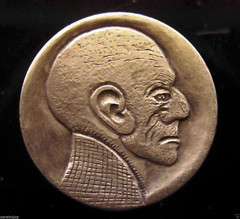 While surfing eBay this one caught my eye because of our earlier discussion of bald people on coins. It's called "Jason's Uncle".
While surfing eBay this one caught my eye because of our earlier discussion of bald people on coins. It's called "Jason's Uncle".
To read the complete eBay lot description, see:
Superior Hobo Nickel Carving "Jason's Uncle"
(www.ebay.com/itm/Superior-Hobo-Nickel-Carving-Jasons-Uncle/231204412984)
To read the earlier E-Sylum article, see: NOTES FROM E-SYLUM READERS: MARCH 30, 2014 : Still More Bald People on Coins (www.coinbooks.org/esylum_v17n13a08.html)

CUOMO-MUST-GO OVERSTAMPS CIRCULATING IN NEW YORK
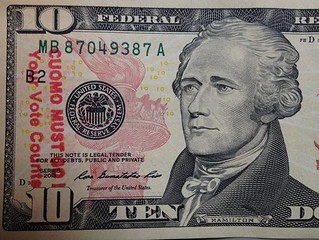 They are circulating as far north as Lake Champlain, being spotted in the Hudson Valley, and creeping over the state line into Pennsylvania: U.S. paper currency stamped "Cuomo Must Go! Your Vote Counts."
They are circulating as far north as Lake Champlain, being spotted in the Hudson Valley, and creeping over the state line into Pennsylvania: U.S. paper currency stamped "Cuomo Must Go! Your Vote Counts."
The source of the red-ink markings is a stamp sold by Jim Arendt, a retailer in Spencerport just outside of Rochester whose creation is catching on with New Yorkers disenchanted with New York Gov. Andrew Cuomo, particularly gun owners stewing over some of the toughest gun laws in the country.
Comment threads on websites and blogs popular with gun-rights advocates suggest buyers are not only stamping money, but invoices, utility bills, greeting cards and whatever else they can get their hands on to vent their disdain.
"I have been stamping everything under the sun in Fulton County!" wrote a commenter on a nyfirearms.com forum called "Cuomo Must Go Currency."
"We don't make the stamps specifically for stamping currency," Arendt said. "People get the stamps and they stamp everything they see."
One commenter on the "Cuomo Must Go Currency" thread wrote, "I have even stamped my restaurant bills when I sign for it!!" Another, from northern Pennsylvania, wrote that her husband stamped his Verizon bill.
But it's money that is moving and spreading the message.
"Been using mine every day when I have cash on me," wrote a commenter from Clinton County, near the Quebec border.
Stampers who believe they are surreptitiously engaging in an act of civil disobedience may be disappointed to learn that defacing currency in such a manner is not illegal.
Defacing a bill is not illegal unless it is done with the intent to render the bill unfit to be reissued, according to federal statute. Stamping a bill does not destroy currency any more than scribbling one's initials on it.
Indeed, the issue was of so little concern to the Treasury Department's Bureau of Engraving and Printing and the Secret Service, which enforces the defacement law, that spokesmen there shrugged off questions on the matter and referred them to the U.S. Attorney's Office.
A spokesman for U.S. Attorney William Hochul pointed to the statute and agreed that stamping bills in this fashion would not violate the law.
Arendt, who sells the stamps for $8.50 plus tax, said the aim of the stamp is to "normalize" gun owners by lending the impression through ubiquity that they are everywhere.
"The more people that are realized as gun owners, the better it is for our cause," Arendt said. "Gun owners are not the crazed psychos you read about in the news everyday."
To read the complete article, see: Cash denouncing Cuomo spreads across N.Y. (www.usatoday.com/story/news/nation/2014/04/23/cash-denouncing-cuomo-spreading-across-ny/8065587/)
RARE ALBERT MEDAL SOLD AT AUCTION
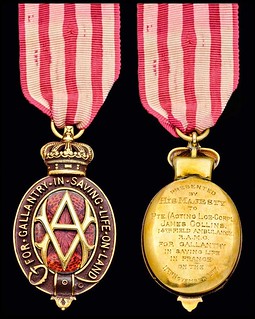 The astonishing story of how a soldier stood on a bomb to save his comrades and recovered enough to go on to play professional football has emerged after his medals were sold.
The astonishing story of how a soldier stood on a bomb to save his comrades and recovered enough to go on to play professional football has emerged after his medals were sold.
Lance Corporal James Collins was advised to have his lower right leg amputated after being seriously injured in the blast in the trenches on the Western Front.
But the talented footballer refused to allow medics to remove the limb and instead underwent 14 operations over the next two years to save his foot.
After recovering and with his foot still riddled with shrapnel, he signed for Swansea City FC and went on to play for the Welsh club for 15 years, rising to captain.
He was awarded the Albert Medal for his heroics while serving in the Royal Army Medical Corps on November 11, 1917.
By treading on the live grenade, the First World War soldier saved the lives of two colleagues who escaped the explosion unscathed.
The rare medal, which was replaced by the George Medal and is the civilian version to the Victoria Cross, has now been sold at auction for nearly £22,000.
King George V presented L/Cpl Collins with the medal at Buckingham Palace.
To read the complete article, see: Rare medal sale reveals story of soldier who became professional footballer after standing on bomb to save comrades (www.mirror.co.uk/news/uk-news/world-war-i-rare-medal-3470869)
BRITISH ARMY DOG AWARDED DICKIN MEDAL
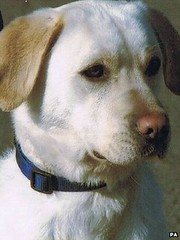 A British Army dog killed alongside her handler in Afghanistan is to be honoured with what is called the highest military award for an animal.
A British Army dog killed alongside her handler in Afghanistan is to be honoured with what is called the highest military award for an animal.
Sasha, a four-year-old yellow Labrador who was trained to hunt out explosives, is credited with saving the lives of scores of soldiers and civilians.
She will be awarded the PDSA Dickin Medal, which the charity says is the animal version of the Victoria Cross.
The PDSA said: "Sasha's determination to search and push forward - despite gruelling conditions and relentless Taliban attacks - was a morale boost to the soldiers who entrusted their lives to her weapon-finding capability.
"On one occasion recalled by regimental colleagues, Sasha was searching a building in Garmsir when she detected two mortars and a large quantity of weaponry, including explosives and mines.
"This find alone undoubtedly saved the lives of many soldiers and civilians."
In 2008 she was assigned to 24-year-old L/Cpl Rowe and the pair were considered the best in the Kandahar region.
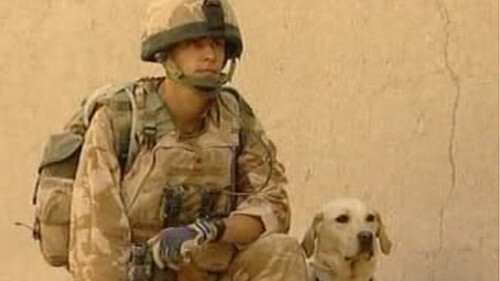
L/Cpl Rowe and Sasha working together in Afghanistan
They died together on 24 July 2008 when their routine patrol was ambushed by a rocket-propelled grenade attack.
L/Cpl Rowe, from West Moor near Newcastle, had been due to return home the day before he died but wanted to stay on to complete a planned operation because he was concerned about a lack of cover for comrades.
Sasha had 15 confirmed finds of Improvised Explosive Devices (IEDs), mortars and hidden weaponry.
Col Neil Smith QHVS, director of the Army Veterinary and Remount Services, said: "This prestigious award recognises how her devotion and skills undoubtedly saved the lives of many troops in Afghanistan, and acknowledges the excellent work our military working dogs and their handlers do.
To read the complete article, see: Army dog killed in Afghanistan given posthumous medal (www.bbc.com/news/uk-27186205)
THE BOOK BAZARRE
SIR JOHN HOUBLON £50 BANKNOTES BEING RETIRED
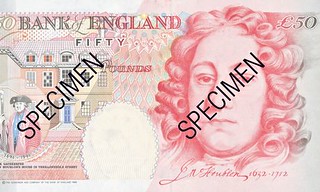 If you have a £50 note anywhere check it now: if the face that features on it is Sir John Houblon then you only have until Wednesday to spend it.
If you have a £50 note anywhere check it now: if the face that features on it is Sir John Houblon then you only have until Wednesday to spend it.
After 30 April, notes carrying the image of the first governor of the Bank of England will no longer be legal tender, meaning retailers will not be able to accept them.
Although the withdrawal of the Houblon note was announced in January, the Bank's latest estimate suggested that 53m notes worth £2.65bn were in circulation a fortnight ago.
It said that it was not unusual for notes to remain in people's hands after they ceased to be legal tender. Almost four years after the £20 Elgar note was withdrawn, the Bank said it believed 80m worth £1.6bn were still outstanding.
After Wednesday only the £50 note featuring Matthew Boulton and James Watt, which was introduced in November 2011, will hold legal tender status.
Anyone holding Houblon notes should be able to pay them into a deposit account held at a bank or building society.
Barclays, NatWest, RBS, Ulster Bank and the Post Office have all agreed to exchange the notes, up to the value of £200, until 30 October 2014.
At any point, members of the public can get notes exchanged by the Bank of England, either by visiting its premises in London or by post.
To read the complete article, see: It's time to offload these £50 notes (www.theguardian.com/money/2014/apr/28/50-pound-notes-bank-of-england-houblon)
COINS STRUCK FOR 2014 GLASGOW GAMES
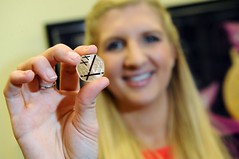 OLYMPIC swimming hero Rebecca Adlington was given another golden honour yesterday when she helped produce the first special commemorative coin for the forthcoming Commonwealth Games in Glasgow.
OLYMPIC swimming hero Rebecca Adlington was given another golden honour yesterday when she helped produce the first special commemorative coin for the forthcoming Commonwealth Games in Glasgow.
The 25-year-old, who won a double-gold haul at the 2008 Olympics in Beijing, visited the headquarters of the Royal Mint in Llantrisant, South Wales to help strike the limited-edition gold coin, which is worth £725.
Another limited-edition version of the regular 50 pence piece has also been produced to mark the staging of the 20th Commonwealth Games in Glasgow, for which Adlington was named an official ambassador shortly before she announced her retirement from the sport. It will go into circulation in July.
The design of the coin, by Alex Loudon, features a cyclist and an athlete, as well as lettering inspired by Glasgow’s most celebrated architect, Charles Rennie Mackintosh, and a saltire.
Adlington, who also won two bronzes in the 2012 Olympics, met some of the Royal Mint experts who designed the medals for the London Games.
She said: “It was particularly special for me to visit the Royal Mint because I got to see the very building where my London 2012 medals were struck.
To read the complete article, see: Rebecca Adlington gets gold with Glasgow 2014 50p (www.scotsman.com/news/uk/rebecca-adlington-gets-gold-with-glasgow-2014-50p-1-3395099)
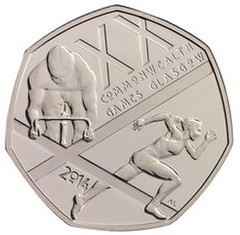 Coins marking the Commonwealth Games in Glasgow and the 100th anniversary of the start of World War One will enter circulation in 2014.
Coins marking the Commonwealth Games in Glasgow and the 100th anniversary of the start of World War One will enter circulation in 2014.
The Royal Mint has released details of the new coin designs that will feature on the 50p, £1 and £2 coins.
The success of coins marking the London 2012 Olympics has prompted the Mint to produce a coin to mark the Commonwealth Games in 2014 in Glasgow.
The 50p coin will feature two sports - athletics and cycling - as well as the Saltire of Scotland.
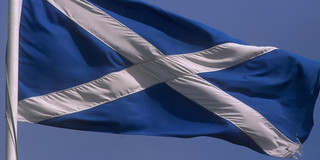
To read the complete article, see: New coin designs for 2014 unveiled by The Royal Mint (www.bbc.com/news/business-25558632)
SCOTLAND CONSIDERS CURRENCY CHOICES

Scotland could revert to a 400-year-old currency called the “merk” if it becomes an independent country, an eminent economist has suggested.
Professor Gavin McCrone, a former chief economist at the Scotland Office, said that the new state could follow the example of the Republic of Ireland when it split from the United Kingdom in 1922 – by establishing its own currency which is pegged to the pound.
But after an initial period of monetary union with the rest of the UK, “sooner rather than later a Scottish government would find it necessary to set up its own central bank as lender of last resort, which would also have power to issue its own currency”.
He added: “This could be the restoration of the pre-1707 pound Scots, or indeed the merk, and it could be pegged against sterling initially on a one-to-one basis, as Ireland’s currency was for a long time, which would reduce transaction costs.”
The merk was a silver coin in use in Scotland in the 16th and 17th centuries, worth 13 shillings and 4 pence or about one English shilling. Half-merk and quarter-merk coins were also issued.
If Professor McCrone’s merk idea does not find favour, Scotland has an extensive range of former coins from which to draw inspiration, including the dollar, pistole, lion, ryal, ducat, “sword and sceptre” and even the unicorn, a coin issued by James III in the 15th century. Lower-value coins included the bawbee, groat, testoon and plack.
To read the complete article, see: Merks and bawbees: Scotland looks at its currency choices ahead of independence vote (www.independent.co.uk/news/uk/politics/merks-and-bawbees-scotland-looks-at-its-currency-choices-ahead-of-independence-vote-9322868.html)
RUSSIA, KAZAKHSTAN AND BELARUS PLAN JOINT CURRENCY
In May 2014, presidents of Russia, Kazakhstan and Belarus will sign an agreement on the establishment of the Eurasian Economic Union. Sections 9 and 11 the agreement, the draft of which is available on the official website of the Russian Ministry for Economic Development, are devoted to the joint monetary policy and financial markets. During the first stage, it is planned to set up an advisory board of the heads of central banks of participating states. The banks would be responsible for the rate of national currencies, regulation of banking and insurance activities and the harmonization of the securities market.
According to the Moskovsky Komsomolets newspaper that cited a source in the Eurasian Economic Commission, the document stipulates for the establishment of the Eurasian Central Bank - the supranational megaregulator of the joint currency. The Eurasian Central Bank will be subordinated to the council of presidents or prime ministers of the EEU.
The name of the new joint currency has been supposedly coordinated - altyn. The new currency is likely to be introduced not later than in 2025, although international economic sanctions against Russia may cut the process to 3-5 years.
The idea of the new joint currency belongs to Kazakh President Nursultan Nazarbayev. In 2012, the idea found support with Vladimir Putin and Dmitry Medvedev. In Russia, altyn was the word to refer to three-kopeck coins.
Altyn had been in circulation on the territory of several Russian principalities from the XV century. The coins appeared simultaneously with the beginning of the era of coinage. Interestingly, the altyn was used as a Eurasian currency immediately after it appeared. This coin was used in calculations between Russian and Asians nationals. In the XVII century, 20 altyn could buy a live calf, five - a piglet, two or three - a goose.
The name of the coin could be borrowed from the Golden Horde, where there was a coin of the same name. According to researchers, the word "altyn" comes from the Turkic numeral "alti" which means "six." Others believe that Russia simply adopted the Turkic word "gold" that sounds just like the name of the coin. However, the altyn was never coined in gold. Originally, it was made of copper; the silver altyn appeared during the times of Peter the Great.
In 1839, under Nicholas I, the altyn was revived in the form of copper coins of three kopecks. Three-kopeck copper coins were used during the Soviet era, although the coins lost the original name. The coins of this value disappeared after 1991.
To read the complete article, see: (english.pravda.ru/russia/economics/10-04-2014/127325-russia_kazakhstan_belarus_new_currency-0/) Russia, Kazakhstan and Belarus to have new joint currency by 2025
The Altyn is a neat coin. The first examples were struck under Tsar Alexei Mikhailovich using dies used for silver kopecks. The inscriptions on the Altyns are complete whereas the normal kopecks only have bits and pieces.
The coins from my understanding were more ceremonial than an actual currency - perhaps used as decorations or maybe like Maundy money. Under Peter the Great, the coin was struck as a 3 kopeck piece starting in 1704. I have an example in my collection but I am traveling so I cannot send a scan. It's a small silver coin maybe the size of a half dime with the Russian double-headed eagle on one side and the inscription reading roughly Altyn 1704 (in Cyrillic numerals) and the mintmark BK. It was struck off and on through the early 18th century but eventually became a copper coin and no longer called by the Altyn name.
To read the complete Wikipedia article, see: Altyn (en.wikipedia.org/wiki/Altyn)
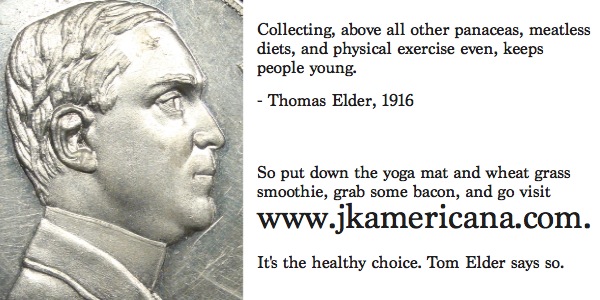
THE MOORE PENNY BANK REFERENCE COLLECTION
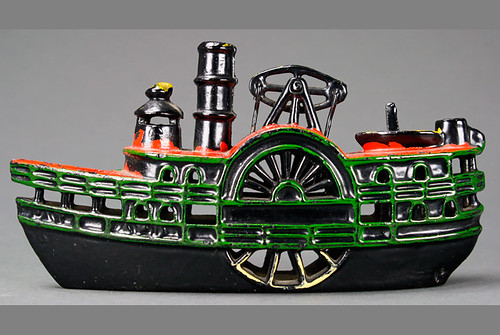
On Saturday, June 7th, RSL Auction Company will offer the premier still and mechanical bank collection of Andy Moore and Susan Moore, authors of the classic 1984 reference “The Penny Bank Book.” The auction of nearly 700 lots, which will take place at RSL’s recently inaugurated gallery in central New Jersey, will also feature the lifetime mechanical bank collections of Bill Robison and Rich Garthoeffner. All forms of bidding will be available, including live via the Internet.
“To still bank collectors, there is no more important book than the one that Andy and Susan Moore wrote. Its publication is what brought still banks to national prominence and got the hobby rolling in a big way,” said RSL partner Ray Haradin. “Collectors are going to be very excited about the prospect of bidding on book examples from this famous, long-held grouping of banks. There are three or four world-class examples of banks that haven’t been on the market in ages.”
Like so many early bank collectors, Andy Moore (1937-1986) made his living in the financial world. For 11 years, he served as president of Beverly Bank in Chicago. He and his wife, Susan, built their bank collection together over a 17-year period and displayed it with pride in their comfortable suburban home.
“In 1993, much of the Moore collection was sold, but the family retained the cream,” Haradin said. “That’s what we’ll be selling.”
The Moore portion of the sale numbers 130 banks – 50 mechanicals and 80 stills, most of which are actual examples shown in “The Penny Bank Book.” That includes the finest-known circa-1890 Transvaal Money Box, which was chosen for the book’s cover.
One of the top lots, a prized Circuit Rider bank, depicts a man – perhaps a traveling minister, as the name would suggest – on a horse. It is technically a semi-mechanical bank, Haradin explained, because it has a retainer that holds a coin in place until the horse is rocked forward and the deposit is made. Its presale estimate is $15,000-$25,000.
Within the Moore collection are examples of nine of 13 figural “safe” banks manufactured around 1895 by the Chicago company Harper. They include Little Red Riding Hood, Santa Claus, a carpenter, and the first version with Old Mother Hubbard on its façade that Haradin has ever seen.
To read the complete article, see: Penny Bank Auction showcases the Andy and Susan Moore reference book still bank collection (artdaily.com/news/69743/Penny-Bank-Auction-showcases-the-Andy-and-Susan-Moore-reference-book-still-bank-collection#.U2Y1MfmcJRQ)
HORSE FEED PURCHASED WITH COUNTERFEIT BILLS
Rogue Rover police are investigating who passed off a pair of counterfeit $100 bills to local businesses over the weekend and trying to identify two persons of interest.
One of the $100 bills was paid to a cashier at Ace Hardware-Main Building Supply on Saturday and another was handed off at Rogue River Pharmacy on a unknown date, Rogue River Police Chief Ken Lewis said.
The persons of interest are described as a white woman of a medium build in her mid 40s with dark blond hair and a white man of average height in his mid 40s with dark hair, Lewis said.
The pair purchased a bale of alfalfa and horse feed at the building supply store.
To read the complete article, see: Rogue River police investigate counterfeit $100 bills (www.mailtribune.com/apps/pbcs.dll/article?AID=/20140429/NEWS07/404290339)
FEATURED WEB PAGE: THE VICTORIA CROSS
This week's Featured Web Page is suggested by Don Cleveland, who writes:The following is a link to a site describing the background of the Victoria Cross. Note that Victoria Cross medals are made from metal taken from a Chinese-made cannon used by the Russians in the Crimean war (history repeats itself).
From the page:
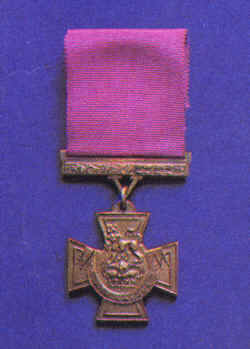 The Victoria Cross had its origins in the Crimean War. This was the first major war that was reported on by war correspondents in the field. In this case, William Howard Russell of “The Times” reported on the bravery of the common soldier and pushed for a bravery award that could be given to the common soldier in recognition of his bravery. At this time, only senior officers were awarded medals for bravery as it was deemed that it was their leadership that drove men on to victory.
The Victoria Cross had its origins in the Crimean War. This was the first major war that was reported on by war correspondents in the field. In this case, William Howard Russell of “The Times” reported on the bravery of the common soldier and pushed for a bravery award that could be given to the common soldier in recognition of his bravery. At this time, only senior officers were awarded medals for bravery as it was deemed that it was their leadership that drove men on to victory.
Senior military figures were against such a medal. They believed that the strength of the British Army lay in its ability to fight in formations on the command of an officer. There was a concern that individuals might engage in acts of individual bravery (in an attempt to win the medal) and break the strength of a formation in doing so. However, the idea had one major supporter – Prince Albert, the husband of Queen Victoria.
The Victoria Cross was meant to have a simple design though in an era when medals for bravery were anything but simple, the design won few friends in the media of the time. “The Times” called the medal "poor looking and mean in the extreme.” The first one was made to the specifications of Prince Albert who wanted a “simple cross”. It is said that Victoria was delighted by the final version – she added a V to link the medal ribbon to the medal itself.
www.historylearningsite.co.uk/victoria_cross.htm

